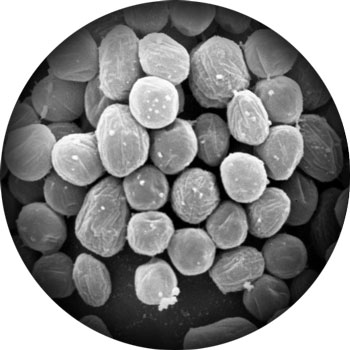
Rhizopus oligosporus
Saito 1905 (syn.Rhizopus microsporusvar.oligosporus(Saito) Schipper & Stalpers)
Rhizopus oligosporusis a mold belonging to the familyMucoraceaeand is widely used to produce fermented food products. Even though originating from a harmfulRhizopuspathogen species,R. oligosporusis essentially harmful to humans when consumed. Furthermore, the species can produce certain beneficial compounds which limit the growth of potentially harmful microorganisms.
Rhizopus oligosporusclassification
Rhizopus oligosporusis today classified asR microsporusvar.oligosporus. SeveralRhizopustaxa (includingR. oligosporus) were considered separate species based on morphology traits such as propagule size, shape, and ornamentation. However, with modern molecular tools, we now distinguish theR. oligosporusas anR. microsporusvariety, belonging to the section “micro-Rhizopus” (1). Furthermore,R. oligosporusis considered to be a domesticated form ofR. microsporus, which has lost its ability to produce toxins through the process of domestication (2,3).
Rhizopus oligosporusmorphology and cultivation
Colonies are pale yellowish to greyish-brown. Rhizoids are simple, semi-translucent (subhyaline). Sporangiophores and rhizoids appear on stolons up to 300 μm long and 15 μm wide, brownish. Sporangiophores emerge in groups of 1-3. Sporangia are dark, up to 80 μm in diameter. Sporangiospores globose to subglobose, mostly up to 9 μm diameter, diverse in size, high proportion irregular spores (>10 %) (Fig. 1) (1,3).
Rhizopus oligosporusoptimally grows at temperatures between 30-35 °C (86-95 °F), with a minimum growing temperature of 12 °C (53.6 °F), and a maximum of 45 °C (107.6 °F) (4). The hyphal extension rate is somewhat sensitive to the pH, and the optimum value should be kept at pH= 5.85 (5,6).R. oligosporusgrows best at the media water activity of Aw= 0.98 and a 12.5% CO2.

Rhizopus oligosporusfermentation
PureRhizopus oligosporuscultures are used to produce Tempeh – a fermented soy-based dish popular in Indonesia. In essence, tempeh is a molded soybean cake, andR. oligosporusis the preferred mold starter for tempeh production for several reasons.
To create tempeh, soybeans must be soaked in water first and kept soaked overnight at a temperature similar to the surrounding environment. Even though air temperature can get rather high in Indonesia,R. oligosporus可以有效地增长在高温下(30-40°C). Under these conditions,R. oligosporusexhibits strong enzymatic activity needed to create the desirable properties in tempeh. Furthermore, the benefits of usingR. oligosporusfor tempeh production are also the rapid spore germination and allelopathy against other competing microorganisms. It produces certain metabolites (antibiotics and chitinases) which can inhibit the growth of other molds and bacteria, including the potentially toxicAspergillus flavusandStaphylococcus aureus(3,4).
Tempeh
Principally, the initial stage in tempeh production is to inoculate the soybeans with a starter culture ofR. oligosporus, and the beans are then spread into a thin layer. As such, the soybeans are fermented for two to three days at a temperature around 30°C (86°F). During the fermentation process, the pH of the substrate should be maintained at pH= 3-5 by adding a mild acidulant such as vinegar. Next, the mass needs to cool down for optimal and rapid mycelium growth, but it will naturally rise afterward (due to the microorganism action). After around 4 hours, as the fungi growth declines, the beans will be compacted into a solid mass by the fungal mycelium (Fig. 2) (3,4,7).

A more traditional way of producing tempeh is by using the leaves ofHibiscus tiliaceus. As the trichomes growing on the underside ofH. tiliaceus叶子自然可能包含R. oligosporus, the soybeans are pressed and stored into the leaves. The resulting fermentation, if not contaminated, should result in whitish tempeh (7,8). On average, 100 g (3.5 oz) of tempeh contains 192 kcal (803 kJ), of which 7.64 g are carbohydrates, 10.80 g are fats, and 20.29 g of proteins. Tempeh also contains various vitamins such as B1 to B3, B6, B9, minerals, and water (9).
Bibliography
- Schipper, M. A. (1984). Revision of the genus Rhizopus. Stud. Mycol., 25, 1-34.
- Jennessen, J., Nielsen, K. F., Houbraken, J., Lyhne, E. K., Schnürer, J., Frisvad, J. C., & Samson, R. A. (2005). Secondary metabolite and mycotoxin production by the Rhizopus microsporus group.Journal of agricultural and food chemistry,53(5),1833-1840.
- Jennessen, J., Schnürer, J., Olsson, J., Samson, R. A., & Dijksterhuis, J. (2008). Morphological characteristics of sporangiospores of the tempe fungus Rhizopus oligosporus differentiate it from other taxa of the R. microsporus group.Mycological research,112(5),547-563.
- Duniaji, A. S., Wisaniyasa, W., Puspawati N. N, Indri, D. N. (2019) Isolation and Identification ofRhizopus oligosporusLocal Isolate Derived from Several Inoculum Sources.IntJCurrMicrobiolAppSci,8(9):1085-98.
- Sparringa, R. A., Kendall, M., Westby, A., & Owens, J. D. (2002). Effects of temperature, pH, water activity, and CO2 concentration on the growth of Rhizopus oligosporus NRRL 2710.Journal of Applied Microbiology,92(2), 329-337.
- Wang, H. L., Swain, E. W., & Hesseltine, C. W. (1975). Mass production of Rhizopus oligosporus spores and their application in tempeh fermentation.
- Watanabe, N., Fujimoto, K., & Aoki, H. (2007). Antioxidant activities of the water-soluble fraction in tempeh-like fermented soybean (GABA-tempeh).International Journal of Food Sciences and Nutrition,58(8), 577-587.
- Muzdalifah, D., Athaillah, Z. A., Nugrahani, W., & Devi, A. F. (2017, January). Colour and pH changes of tempe during extended fermentation. InAIP conference proceedings(Vol. 1803, No. 1, p. 020036). AIP Publishing LLC.
- USDA FoodData Central [Internet]. Available from:fdc.nal.usda.gov
Published:July 20, 2021Updated:August 19, 2021

Written by:
Dusan Sadikovic
Mycologist - MSc, PhD
官网入口
Fact checked by:
Charles Leduc
CPI, CMI, CMR
官网入口

Looking for mold library dataset or machine learning algorithm for training your AI?
Mold Busters created anopen-source library of microscopy imagesof various kinds of mold which are used to train machine learning algorithms. If you would like to get access to it, just fill out the form below and we will contact you shortly: